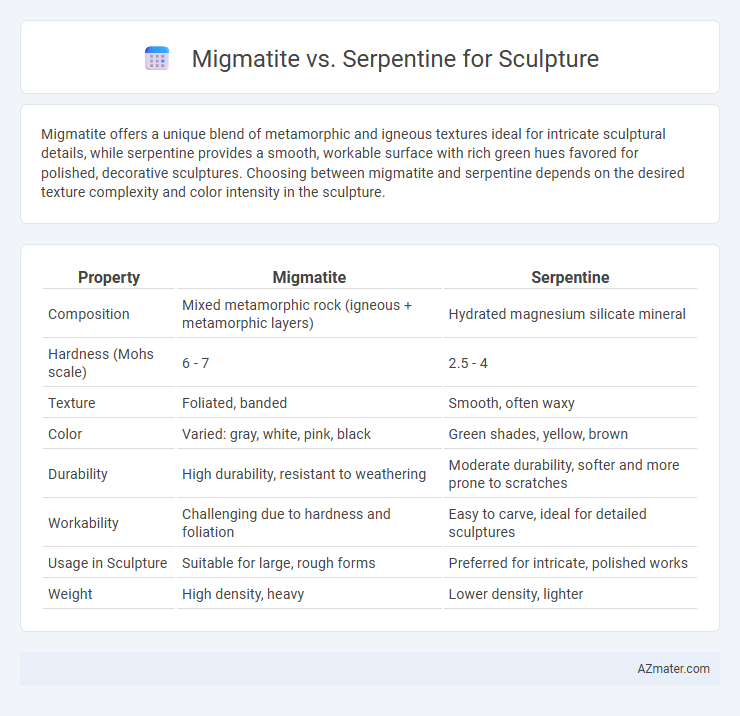Migmatite offers a unique blend of metamorphic and igneous textures ideal for intricate sculptural details, while serpentine provides a smooth, workable surface with rich green hues favored for polished, decorative sculptures. Choosing between migmatite and serpentine depends on the desired texture complexity and color intensity in the sculpture.
Table of Comparison
| Property | Migmatite | Serpentine |
|---|---|---|
| Composition | Mixed metamorphic rock (igneous + metamorphic layers) | Hydrated magnesium silicate mineral |
| Hardness (Mohs scale) | 6 - 7 | 2.5 - 4 |
| Texture | Foliated, banded | Smooth, often waxy |
| Color | Varied: gray, white, pink, black | Green shades, yellow, brown |
| Durability | High durability, resistant to weathering | Moderate durability, softer and more prone to scratches |
| Workability | Challenging due to hardness and foliation | Easy to carve, ideal for detailed sculptures |
| Usage in Sculpture | Suitable for large, rough forms | Preferred for intricate, polished works |
| Weight | High density, heavy | Lower density, lighter |
Introduction to Migmatite and Serpentine
Migmatite, a hybrid rock formed through the partial melting of metamorphic rocks, combines both igneous and metamorphic characteristics, offering unique visual textures and durability ideal for sculpture. Serpentine, a group of greenish, soft to moderately hard minerals, is valued for its smooth texture, ease of carving, and wide range of colors that enhance sculptural details. Both stones provide distinct aesthetic and physical properties, influencing the choice of material for specific artistic applications.
Geological Origins: Migmatite vs Serpentine
Migmatite forms through high-grade metamorphism where igneous and metamorphic processes partially melt and recrystallize original rock, creating a complex amalgam of light and dark mineral bands ideal for intricate sculptural textures. Serpentine originates from the hydration and metamorphic transformation of ultramafic rocks, primarily peridotite, resulting in smooth, often greenish mineral masses favored for their workability and unique aesthetic in sculpture. Understanding their distinct geological origins highlights migmatite's banded complexity versus serpentine's uniform, softer characteristics valuable for artistic carving.
Physical Properties Comparison
Migmatite features a unique blend of metamorphic and igneous characteristics, exhibiting high hardness around 6-7 on the Mohs scale and a coarse-grained texture ideal for detailed sculpting. Serpentine, softer at about 2.5-5.5 on the Mohs scale, offers a smooth, waxy texture with excellent workability but lower structural durability. Migmatite's resistance to weathering makes it suitable for outdoor sculptures, while serpentine's attractive green hues and ease of carving favor indoor decorative pieces.
Workability and Sculpting Techniques
Migmatite offers a challenging workability due to its mixed metamorphic composition, requiring precise chiseling and polishing techniques to highlight its intricate banding and mineral contrast. Serpentine, valued for its softness and smooth texture, allows easier carving and fine detailing, making it ideal for intricate sculptures and delicate forms. Sculptors working with migmatite often use power tools to manage hardness variation, while serpentine typically demands traditional hand tools to emphasize its buttery surface and subtle color transitions.
Color and Texture Differences
Migmatite exhibits a striking blend of light and dark minerals, creating a marbled pattern with a coarse, granular texture ideal for detailed sculptural work. Serpentine features rich green hues ranging from olive to emerald, combined with a smooth, waxy texture that is easier to carve and polish. The contrasting color vibrancy and tactile qualities make migmatite preferred for bold, textured pieces, while serpentine suits intricate, polished sculptures.
Durability and Longevity in Art
Migmatite, a high-grade metamorphic rock with a mixed composition of igneous and metamorphic features, offers exceptional durability and resistance to weathering, making it ideal for long-lasting sculptures exposed to various environmental conditions. Serpentine, known for its softness and relatively low hardness, is more prone to scratching and erosion, which can limit its longevity in outdoor or high-traffic art installations. For sculptors prioritizing durability and longevity, migmatite ensures structural integrity over time, while serpentine requires more careful maintenance to preserve its aesthetic qualities.
Aesthetic Appeal in Finished Sculptures
Migmatite offers a captivating aesthetic appeal in finished sculptures due to its striking banded patterns and natural contrast between light and dark mineral layers, creating a dynamic visual texture. Serpentine is prized for its smooth, waxy luster and rich green hues with subtle veining, lending sculptures a polished and organic elegance. Both stones provide unique aesthetic qualities, with migmatite's dramatic patterns appealing to bold, textural works and serpentine's uniform coloration enhancing refined, detailed carvings.
Historical Uses in Sculpture
Migmatite, known for its intricate blend of metamorphic and igneous characteristics, has been historically valued in sculpture for its striking, mottled appearance and durability, often used in architectural embellishments and monuments dating back to the Renaissance. Serpentine, prized for its rich green hues and relative softness, has a long history in decorative arts and sculpture, especially during the 18th and 19th centuries, favored for intricate carving and polishability. Both stones reflect cultural preferences in material aesthetics and functionality, with migmatite's structural complexity contrasting serpentine's versatility and color vibrancy in sculptural works.
Cost and Availability for Artists
Migmatite, characterized by its mixed metamorphic composition, tends to be more expensive and less readily available for artists due to its rarity and extraction challenges. Serpentine, often favored for sculpture, offers a more affordable and widely accessible option, with a softer texture that facilitates carving. Cost efficiency and material availability make serpentine a practical choice for sculptors seeking both quality and budget-friendly options.
Choosing the Right Stone for Sculpture
Migmatite, with its unique blend of metamorphic and igneous characteristics, offers sculptors a durable medium ideal for detailed carvings and large-scale works due to its hardness and striking, swirling patterns. Serpentine, softer and easier to carve, provides a smooth texture and rich green hues that appeal to artists seeking intricate shapes and a polished finish but may be less durable over time. Selecting between migmatite and serpentine depends on the desired durability, carving complexity, and aesthetic, with migmatite favored for structural strength and serpentine for its workability and vibrant color.

Infographic: Migmatite vs Serpentine for Sculpture
 azmater.com
azmater.com